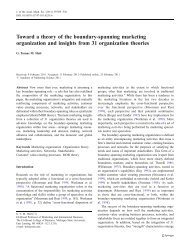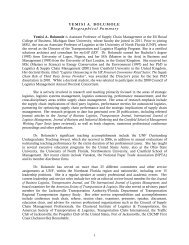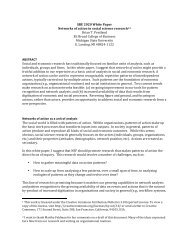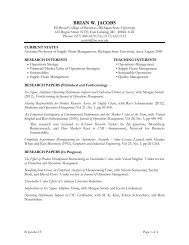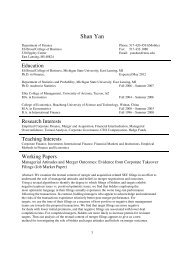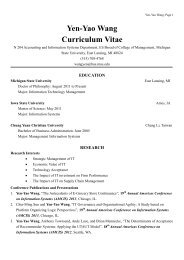Journal of Business logistics, Vol. 28, no. 2, 2007 ... - Global Initiatives
Journal of Business logistics, Vol. 28, no. 2, 2007 ... - Global Initiatives
Journal of Business logistics, Vol. 28, no. 2, 2007 ... - Global Initiatives
You also want an ePaper? Increase the reach of your titles
YUMPU automatically turns print PDFs into web optimized ePapers that Google loves.
<strong>Journal</strong> <strong>of</strong> <strong>Business</strong> Logistics, <strong>Vol</strong>. <strong>28</strong>, No. 2, <strong>2007</strong> 1071999; Boyer and Olson 2002). While service and product quality are established concepts, e<strong>Business</strong>quality is a relatively new phe<strong>no</strong>me<strong>no</strong>n that can be attributed to the Internet era. As such, companiessuch as Amazon.com, Dell, and Tesco thrive partly because <strong>of</strong> their ability to <strong>of</strong>fer customers an onlineinterface to ordering their products that is user friendly. In fact, user friendly tech<strong>no</strong>logy is <strong>of</strong>tenseen as a core competency by customers and firms alike. This new dimension <strong>of</strong> quality – labelede<strong>Business</strong> quality in our research – has assumed a place alongside service and product quality in affectingcustomer repurchase intentions.One approach to understanding how the concepts <strong>of</strong> service-, product-, and e<strong>Business</strong>-quality,operational <strong>logistics</strong> strategy, and repurchase intentions relate to each other is to search for linearrelationships that apply across all members <strong>of</strong> a sample. A linear understanding <strong>of</strong> relationships iscommonly used in social science studies, and has been applied regularly in quality oriented studies.However, a key disadvantage to this approach is that important relationships may be masked bydata aggregation (Miller 1987). For example, if emphasizing service quality greatly enhances somecustomers’ intentions while having a small effect on others, these effects may “average out” to amodest level in an aggregate analysis. The result is that <strong>no</strong> firm’s situation is depicted as accuratelyas it could be.To <strong>of</strong>fset this potential limitation and to advance the literature both managerially and methodologically,we adopt a focus on configurations – the simultaneous consideration <strong>of</strong> multiple interwovenfactors (Miller 1997). In our study, a configuration refers to a constellation <strong>of</strong> the threequality elements and operational <strong>logistics</strong> strategy (Meyer, Tsui, and Hinings 1993). Configurationaltheory contends that the closer a firm matches an “ideal constellation,” the better its outcomes. Morebroadly, a focus on such configurations avoids the aggregation problem identified by Miller (1987).As such, configuration theory allows for a more managerially relevant assessment <strong>of</strong> the preferredmakeup <strong>of</strong> service-, product-, and e<strong>Business</strong>- quality elements for specific operational <strong>logistics</strong> strategiesthan can be analyzed via linear modeling (cf. Vorhies and Morgan 2003).When fit among multiple elements is considered simultaneously and the effects on outcomesare examined, as in our study, configuration should be conceptualized and measured via pr<strong>of</strong>ile deviationanalysis (Doty, Glick, and Huber 1993; Venkatraman 1990; Vorhies and Morgan 2003). Thisanalysis assesses the fit between the three quality elements and strategy as the degree to which thequality elements <strong>of</strong> a supply chain differ from those <strong>of</strong> an “ideal” pr<strong>of</strong>ile for implementing a specificoperational <strong>logistics</strong> strategy (Vorhies and Morgan 2003; Zajac, Kraatz, and Bresser 2000). Below,we describe the conceptual background for the components <strong>of</strong> the pr<strong>of</strong>iles (quality and operational<strong>logistics</strong> strategy). We then develop hypotheses relating the pr<strong>of</strong>iles and our outcome <strong>of</strong> interest (i.e.,a customer’s repurchase intention).Configurations <strong>of</strong> Quality and Operational Logistics StrategyIn light <strong>of</strong> configuration theory (Doty, Glick, and Huber 1993), coupled with guidance fromstrategic choice theory (Child 1972) and the quality literatures, two major constructs are relevant tounderstanding and assessing quality-based fit with strategy: operational <strong>logistics</strong> strategy types andquality-based supply chain characteristics including service-, product-, and e<strong>Business</strong>-quality. “Strategictype pertains to the planned patterns <strong>of</strong> organizational adaptation to the market through which abusiness seeks to achieve its strategic goals” (Vorhies and Morgan 2003, p. 102; cf. Conant, Mokwa,and Varadarajan 1990; Matsu<strong>no</strong> and Mentzer 2000).




